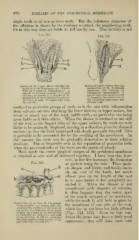Page 960 - My FlipBook
P. 960
970 DISEASES OF THE PERIDENTAL MEMBRANE.
single tooth or of two or three teeth. But the infectious character of
the aifection is shown by the tendency to attack the neighboring teeth,
for in this way they are liable to fall one by one. This lial)ility is not
^^'"•'^^^-
Fig. 519.
Mi-
Section of an Upper Molar showing De- Section of Upper Incisor showing
struction of its Membrane and Alveolar Destruction of its Peridental
Wall by Phagedenic Pericementitis: a, ISIembrane and Alveolus by
deposit of serumal calculus; 6, ft, gum Phagedenic Pericementitis : a,
covering pus-cavity (r, <•) formed by the gum-tissues covering pus-cavity
destruction of the peridental membrane ifc) formed by the destruction of
and alveolar wall. (Compare with Pigs. the peridental membrane and
5uii and 507.) alveolar wall.
confined to particular groups of teeth, as is the case with inflammation
from salivary calculus attacking the lower incisors or upper molars, but
seems to attack any of the teeth indifferently, no particular one being
more liable to it than others. When the disease is confined to one side
of the root, as the lingual sides of the upper incisors, the teeth are very
liable to be gradually displaced, moving in a direction jrom the diseased
surface ; so that the teeth mentioned will slowly protrude forward. This
is probably to be accounted for by the swelling of the membrane. In
this manner the teeth may be gradually distorted as to their relative
positions. This is frequently seen in the separation of particular teeth
when the proximal sides of the roots are the points of attack.
INIore rarely the entire gingival margin of the peridental membrane
is attacked at once and all destroyed together. I have seen this, how-
ever, in but few instances, the formation
FiG. 520. These pock-
of pockets being the rule.
^^^^^-0 cts deepen and waden, and finally encir-
Q,
^'^.-••. \? cle the root of the tooth, but much
f/'
j^ _, Ob ofitener pass up the length of the root
to its apex before it has completely en-
circled it. When the disease is not
com])licated wnth deposits of calculus,
it often happens that the entire apex
of the root is stripped of its membrane,
while the tooth is still held in place by
c
Illustration of a Case of Phagedenic tilC membrane of OUC Sldc ot i* j.1 „ , „„I
r\
•
i
\
Pericementitis: «,«, dotted lines rep- tllC I'OOt,
resenting the outlines of the roots of it; vpt bpPTi but littlp nffpctpd
lint^
\vhiV»h "^'^ ^^ ^^^ "^t!U OUl lltXie ailCLlLU
the teeth; ft. ft, irregular lines repre- ""/<-'!
senting the extent of the destruction (Ficrs. 521 522). EvCll in tllis COll-
''
of the peridental membrane and walls \. .^ ' , ' , /> • i i
of the alveolus. It will be noted that ditiou the guuis mav havc a lairJy good
the nums appear nearly perfect. (Com- .i 'mi I .^,„,I.^ ' ,.^^1
appearaucc they wall show more red-
pare with Figs. -yi\ and 527.) ;


